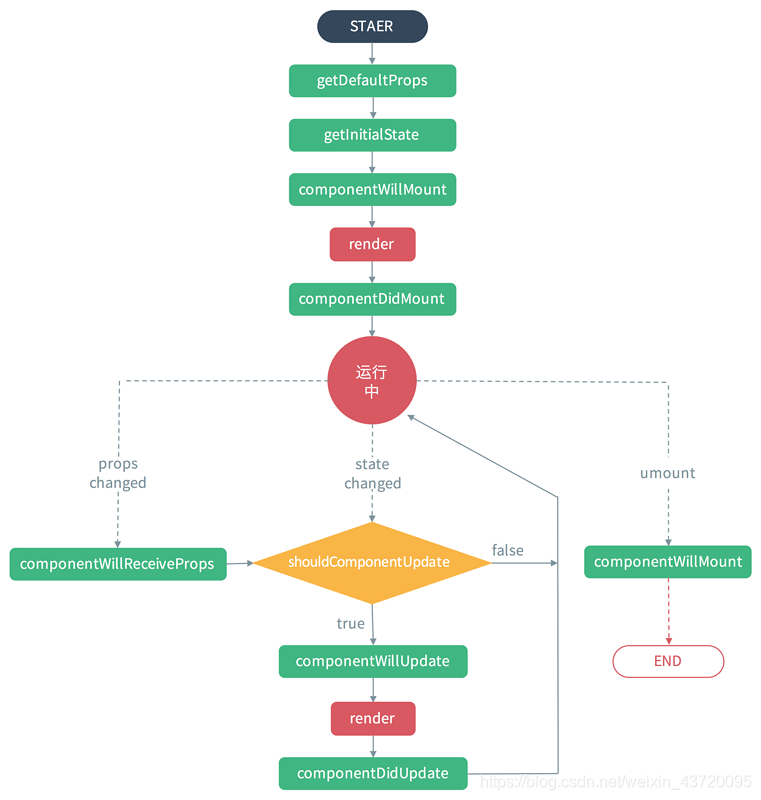在学习vue时候有生命周期的认知,其实react一样也有生命周期。 React的生命周期组件分三个阶段:
- Mounting(加载阶段)
- Updating(更新阶段)
- Unmounting(卸载阶段)
旧生命周期
版本更新我们先看下之前旧的生命周期

以一个例子为例
import React, { Component } from 'react'
class LifeCycleSon extends Component {
constructor(props){
super(props)
this.state={
word: '我是生命周期内的state'
}
console.log('1.constructor构造函数')
}
componentWillMount(){
//组件将要挂在,这个时候我们可以进行api的调用,获取数据,但是不能进行dom操作
console.log('2.componentWillMount组件将要挂载')
}
componentDidMount(){
//此时组件已经挂载,我们可以进行dom操作,可以对我们的状态进行更新操作了
console.log('4.componentDidMount组件已经挂载')
}
componentWillReceiveProps(nextProps){
//父组件传递的属性有变化,我们可以在这里做相应的响应操作
console.log("5.componentWillReceiveProps父组件传递的属性更新了")
}
shouldComponentUpdate(nextProps, nextState){
//组件是否需要更新,需要返回一个布尔值,返回true则更新,返回flase不更新,这是一个优化点
console.log('6.shouldComponentUpdate组件是否应该更新,需要返回布尔值')
return true
}
componentWillUpdate(nextProps, nextState){
//组件将要更新
console.log('7.componentWillUpdate组件将要更新')
}
componentDidUpdate(){
//组件已经更新
console.log('8.componentDidUpdate组件已经更新')
}
componentWillUnmount(){
//组件销毁
console.log("9.componentWillUnmount组件已经销毁")
}
render() {
console.log('3.render组件渲染')
return (
<div>
{this.props.title}
</div>
)
}
}
export default class LifeCycle extends Component {
constructor(props){
super(props)
this.state={
son:'我是生命周期父组件',
showSon:true
}
setTimeout(()=>{
this.setState({
son:'父组件更新',
})
},2000)
setTimeout(()=>{
this.setState({
showSon:false
})
},4000)
}
render() {
return (
<div>
{this.state.showSon?<LifeCycleSon title={this.state.son}></LifeCycleSon>:<div>组件已销毁</div>}
</div>
)
}
}
Mounting(加载阶段:涉及6个钩子函数)
constructor()
加载的时候调用一次,可以初始化state
getDefaultProps()
设置默认的props,也可以用dufaultProps设置组件的默认属性。
getInitialState()
初始化state,可以直接在constructor中定义this.state
componentWillMount()
组件加载时只调用,以后组件更新不调用,整个生命周期只调用一次,此时可以修改state
render()
react最重要的步骤,创建虚拟dom,进行diff算法,更新dom树都在此进行。根据组件的props和state(无两者的重传递和重赋值,论值是否有变化,都可以引起组件重新render) ,return 一个React元素(描述组件,即UI),不负责组件实际渲染工作,之后由React自身根据此元素去渲染出页面DOM。render是纯函数(Pure function:函数的返回结果只依赖于它的参数;函数执行过程里面没有副作用),不能在里面执行this.setState,会有改变组件状态的副作用。
componentDidMount()
组件渲染之后调用,只调用一次
上述的代码挂载结果为

Updating(更新阶段:涉及5个钩子函数)
componentWillReceivePorps(nextProps)
组件加载时不调用,组件接受新的props时调用,所以在此方法中根据nextProps和this.props来查明重传的props是否改变,以及如果改变了要执行啥,比如根据新的props调用this.setState出发当前组件的重新render。根据官网的描述:在该函数(componentWillReceiveProps)中调用 this.setState() 将不会引起第二次渲染。
shouldComponentUpdate(nextProps, nextState)
组件接收到新的props或者state时调用,return true就会更新dom(使用diff算法更新),return false能阻止更新(不调用render)以此可用来减少组件的不必要渲染,优化组件性能。
ps:这边也可以看出,就算componentWillReceiveProps()中执行了this.setState,更新了state,但在render前(如shouldComponentUpdate,componentWillUpdate),this.state依然指向更新前的state,不然nextState及当前组件的this.state的对比就一直是true了。
componentWillUpdata(nextProps, nextState)
组件加载时不调用,只有在组件将要更新时才调用,此时可以修改state,在这边可执行一些组件更新发生前的工作,一般较少用。
render()
render方法在上文讲过,这边只是重新调用。
componentDidUpdate(prevProps, prevState)
组件加载时不调用,组件更新完成后调用,可以操作组件更新的DOM,prevProps和prevState这两个参数指的是组件更新前的props和state
上述的代码更新结果为

造成组件更新的情况
- 父组件重新render
a. 直接使用,每当父组件重新render导致的重传props,子组件将直接跟着重新渲染,无论props是否有变化。可通过shouldComponentUpdate方法优化。
class Child extends Component {
shouldComponentUpdate(nextProps){ // 应该使用这个方法,否则无论props是否有变化都将会导致组件跟着重新渲染
if(nextProps.someThings === this.props.someThings){
return false
}
}
render() {
return <div>{this.props.someThings}</div>
}
}
b.在componentWillReceiveProps方法中,将props转换成自己的state
class Child extends Component {
constructor(props) {
super(props);
this.state = {
someThings: props.someThings
};
}
componentWillReceiveProps(nextProps) { // 父组件重传props时就会调用这个方法
this.setState({someThings: nextProps.someThings});
}
render() {
return <div>{this.state.someThings}</div>
}
}
- 组件本身调用setState,无论state有没有变化。可通过shouldComponentUpdate方法优化。
class Child extends Component {
constructor(props) {
super(props);
this.state = {
someThings:1
}
}
shouldComponentUpdate(nextStates){ // 应该使用这个方法,否则无论state是否有变化都将会导致组件重新渲染
if(nextStates.someThings === this.state.someThings){
return false
}
}
handleClick = () => { // 虽然调用了setState ,但state并无变化
const preSomeThings = this.state.someThings
this.setState({
someThings: preSomeThings
})
}
render() {
return <div onClick = {this.handleClick}>{this.state.someThings}</div>
}
}
Unmounting(卸载阶段:涉及1个钩子函数)
componentWillUnmount()
组件渲染之后调用,只调用一次。此方法在组件被卸载前调用,可以在这里执行一些清理工作,比如清楚组件中使用的定时器,清楚componentDidMount中手动创建的DOM元素等,以避免引起内存泄漏。
上述的代码销毁结果为

新生命周期v16.4
官网链接:
http://projects.wojtekmaj.pl/react-lifecycle-methods-diagram/
https://zh-hans.reactjs.org/docs/react-component.html#getsnapshotbeforeupdate

import React, { Component } from 'react'
class LifeCycleSon extends Component {
constructor(props){
super(props)
// getDefaultProps:接收初始props
// getInitialState:初始化state
this.state={
word: '我是生命周期内的state'
}
console.log('1.constructor构造函数')
}
static getDerivedStateFromProps(nextProps, prevState){
console.log('2.getDerivedStateFromProps-----',nextProps,prevState)
return nextProps
}
componentDidCatch(error, info) { // 获取到javascript错误
console.log('componentDidCatch',error, info)
}
componentDidMount(){
//此时组件已经挂载,我们可以进行dom操作,可以对我们的状态进行更新操作了
console.log('4.componentDidMount组件已经挂载')
}
shouldComponentUpdate(nextProps, nextState){
//组件是否需要更新,需要返回一个布尔值,返回true则更新,返回flase不更新,这是一个优化点
console.log('6.shouldComponentUpdate组件是否应该更新,需要返回布尔值',nextProps, nextState)
return true
}
getSnapshotBeforeUpdate(prevProps, prevState) {
// 组件更新前触发
console.log('7.getSnapshotBeforeUpdate',prevProps, prevState)
return null
}
componentDidUpdate(prevProps, prevState, snapshot){
//组件已经更新
console.log('8.componentDidUpdate组件已经更新',prevProps, prevState, snapshot)
}
componentWillUnmount(){
//组件销毁
console.log("9.componentWillUnmount组件已经销毁")
}
render() {
console.log('3.render组件渲染')
return (
<div>
{this.props.title}
</div>
)
}
}
export default class LifeCycle extends Component {
constructor(props){
super(props)
this.state={
son:'我是生命周期父组件',
showSon:true
}
setTimeout(()=>{
this.setState({
son:'父组件更新',
})
},2000)
setTimeout(()=>{
this.setState({
showSon:false
})
},4000)
}
render() {
return (
<div>
{this.state.showSon?<LifeCycleSon title={this.state.son}></LifeCycleSon>:<div>组件已销毁</div>}
</div>
)
}
}
Mounting(加载阶段:涉及6个钩子函数)
当组件实例被创建并插入 DOM 中时,其生命周期调用顺序如下:
constructor()
加载的时候调用一次,可以初始化state
static getDerivedStateFromProps(nextProps, prevState)
用一个静态函数getDerivedStateFromProps来取代被deprecate的几个生命周期函数,就是强制开发者在render之前只做无副作用的操作,而且能做的操作局限在根据props和state决定新的state,而已。组件每次被rerender的时候,包括在组件构建之后(虚拟dom之后,实际dom挂载之前),每次获取新的props或state之后;每次接收新的props之后都会返回一个对象作为新的state,返回null则说明不需要更新state;配合componentDidUpdate,可以覆盖componentWillReceiveProps的所有用法。
注意:
- getDerivedStateFromProps前面要加上static保留字,声明为静态方法,不然会被react忽略掉
- getDerivedStateFromProps里面的this为undefined。static静态方法只能Class(构造函数)来调用(App.staticMethod✅),而实例是不能的( (new App()).staticMethod ❌ );当调用React Class组件时,改组件会实例化;所以React Class组件中,静态方法getDerivedStateFromProps无权访问Class实例的this,即this为undefined。可以看react issue相关讨论 https://github.com/facebook/react/issues/12612 https://github.com/facebook/react/issues/14730
render()
react最重要的步骤,创建虚拟dom,进行diff算法,更新dom树都在此进行,和上面无差
componentDidMount()
组件渲染之后调用,只调用一次
结果为:

Updating(更新阶段:涉及5个钩子函数)
static getDerivedStateFromProps(props, state)
组件每次被rerender的时候,包括在组件构建之后(虚拟dom之后,实际dom挂载之前),每次获取新的props或state之后;每次接收新的props之后都会返回一个对象作为新的state,返回null则说明不需要更新state;配合componentDidUpdate,可以覆盖componentWillReceiveProps的所有用法
shouldComponentUpdate(nextProps, nextState)
组件接收到新的props或者state时调用,return true就会更新dom(使用diff算法更新),return
false能阻止更新(不调用render)
render()
react最重要的步骤,创建虚拟dom,进行diff算法,更新dom树都在此进行
getSnapshotBeforeUpdate(prevProps, prevState)
触发时间update发生的时候,在render之后,在组件dom渲染之前;返回一个值,作为componentDidUpdate的第三个参数;配合componentDidUpdate,
可以覆盖componentWillUpdate的所有用法
例如官方示例
class ScrollingList extends React.Component {
constructor(props) {
super(props);
this.listRef = React.createRef();
}
getSnapshotBeforeUpdate(prevProps, prevState) {
// 我们是否在 list 中添加新的 items ?
// 捕获滚动位置以便我们稍后调整滚动位置。
if (prevProps.list.length < this.props.list.length) {
const list = this.listRef.current;
return list.scrollHeight - list.scrollTop;
}
return null;
}
componentDidUpdate(prevProps, prevState, snapshot) {
// 如果我们 snapshot 有值,说明我们刚刚添加了新的 items,
// 调整滚动位置使得这些新 items 不会将旧的 items 推出视图。
//(这里的 snapshot 是 getSnapshotBeforeUpdate 的返回值)
if (snapshot !== null) {
const list = this.listRef.current;
list.scrollTop = list.scrollHeight - snapshot;
}
}
render() {
return (
<div ref={this.listRef}>{/* ...contents... */}</div>
);
}
}
componentDidUpdate()
组件加载时不调用,组件更新完成后调用
结果:

Unmounting(卸载阶段:涉及1个钩子函数)
componentWillUnmount()
组件渲染之后调用,只调用一次。此方法在组件被卸载前调用,可以在这里执行一些清理工作,比如清楚组件中使用的定时器,清楚componentDidMount中手动创建的DOM元素等,以避免引起内存泄漏。
上述的代码销毁结果为

componentDidCatch(error,info)
组件渲染之后调用,只调用一次
参考链接
https://zhuanlan.zhihu.com/p/38030418
https://www.jianshu.com/p/50fe3fb9f7c3
